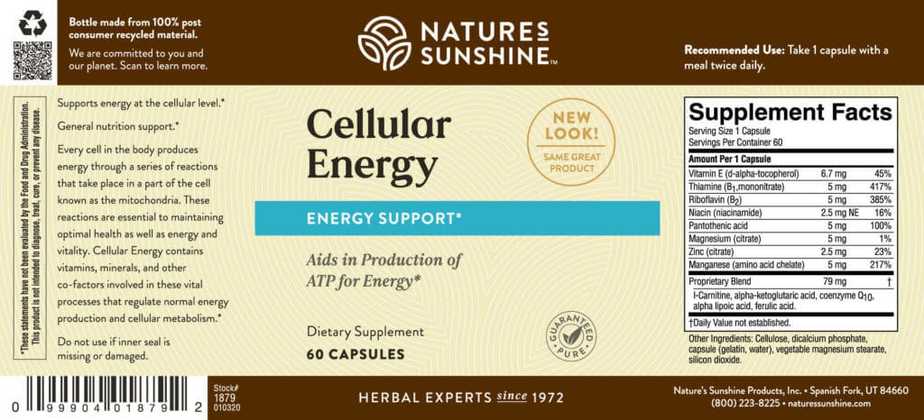The Herbs Place
Cellular Energy
Cellular Energy
Couldn't load pickup availability
Benefits
• Aids in the production of ATP for energy.
• Supports healthy cellular metabolism.
• Supports a healthy biological terrain.
• Provides glandular system support
• Provides 250–330% of the Daily Value of thiamin, riboflavin and manganese.
Nutrients from foods are digested, assimilated and subsequently used for cellular energy production to sustain metabolic processes and physical activities. The excess is stored in the body as glycogen, muscle or fat. The body uses oxygen to metabolize these nutrients for energy production. Unfortunately, some peoples’ ability to use oxygen properly to produce energy is affected because of a physiological condition or reduced nutrient reserves.
Cellular Energy is a blend of nutrients that augments essential nutrient reserves and supports cellular energy production. In addition to their nutritional value, the ingredients of Cellular Energy exert reasonable antioxidant effects that can help address some of the metabolic issues that affect energy production.
How It Works
People who experience fatigue, reduced stamina, feelings of weakness or who need an energy boost for prolonged physical activity may benefit from supplementing their diets with Cellular Energy. It provides highly absorbable forms of the vitamins and minerals needed to boost cellular metabolism. Every body cell produces energy through a series of reactions that take place in a part of the cell known as the mitochondria. These reactions are essential to maintaining optimal health, energy and vitality. Cellular Energy contains vitamins, minerals, amino acids and other co-factors involved in these vital processes that regulate normal energy production and cellular metabolism. The B vitamins in Cellular Energy perform important functions in cellular energy metabolism. Manganese and magnesium support the muscular and skeletal systems, while zinc universally supports all body systems either as an integral part or as a component of enzymes, hormones and body fluids.
Ingredients
The B vitamins in Cellular Energy perform important functions in cellular energy metabolism. Manganese and magnesium support muscular and skeletal systems, while zinc universally supports all body systems either as an integral part or as a component of enzymes, hormones and body fluids.
10 IU vitamin E (35% DV), 5 mg thiamin (330% DV), 5 mg riboflavin (290% DV), 2.5 mg niacin (15% DV), 5 mg pantothenic acid (50% DV), 5 mg magnesium (2% DV), 2.5 mg zinc (15% DV), 5 mg manganese (250% DV), l-carnitine, alpha-keto glutaric acid, co-enzyme Q10, alpha lipoic acid, dimethyl glycine HCl and ferulic acid.
Scientific Support
Scientists are beginning to realize the beneficial effects of a broad-spectrum approach to nutritional optimization of bioenergetics (cellular energy). Studies confirm that the individual ingredients and the combinations of some of the ingredients of Cellular Energy promote energy; improve motor performance of skeletal, cardiac and smooth muscle; and exert other beneficial health effects. 1,2
Review of studies on supplementation with antioxidant nutrients, including some of the ingredients of Cellular Energy, also suggest effective retardation of oxidative stress and aging and elongation of life span as possible benefits. 3,4
Recommended Use
Take 1 capsule with a meal twice daily.
References
1. McCarty MF. Toward a “bio-energy supplement”—a prototype for functional orthomolecular supplementation. Med Hypotheses 1981 Apr;7(4):515-38. 2. Vargiu R, Licheri D, Carcassi AM, Naimi S, Collu M, Littarru GP, Mancinelli R. Enhancement of muscular performance by a coformulation of propionyl-L-carnitine, coenzyme Q(10), nicotinamide, riboflavin and pantothenic acid in the rat. Physiol Behav 2002 Jun;76(2):257-63. 3. Miquel J. Can antioxidant diet supplementation protect against age-related mitochondrial damage? Ann N Y Acad Sci 2002 Apr;959:508-16. 4. Hagen TM, Moreau R, Suh JH, Visioli F. Mitochondrial decay in the aging rat heart: evidence for improvement by dietary supplementation with acetyl-L-carnitine and/or lipoic acid. Ann N Y Acad Sci 2002 Apr;959:491-507.




